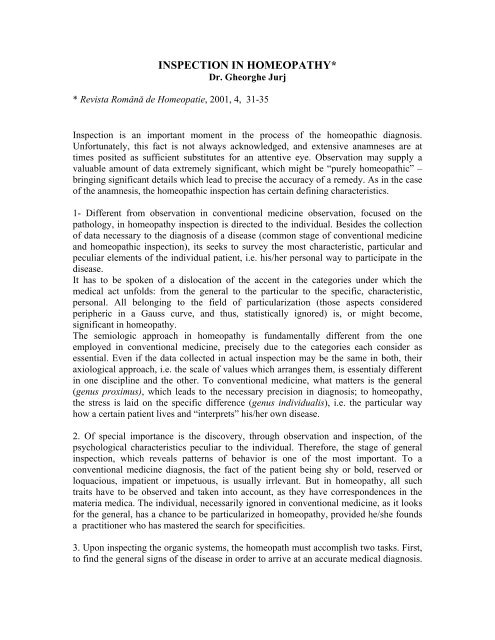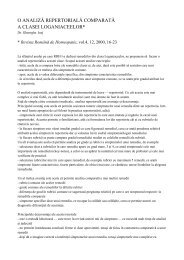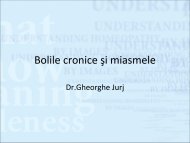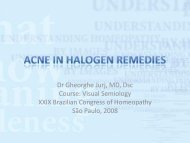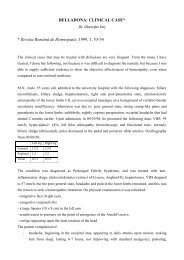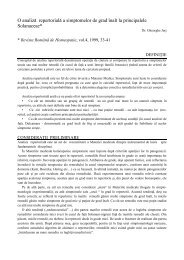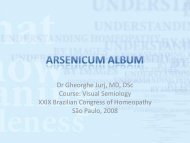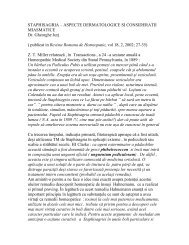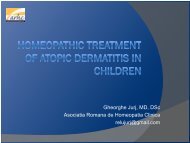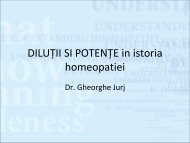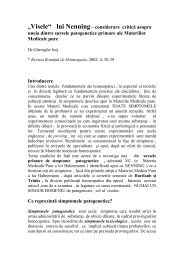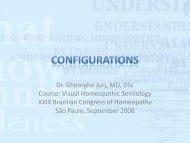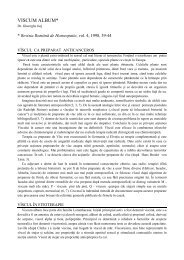inspection in homeopathy - Dr. Gheorghe Jurj - Homeopatie
inspection in homeopathy - Dr. Gheorghe Jurj - Homeopatie
inspection in homeopathy - Dr. Gheorghe Jurj - Homeopatie
- No tags were found...
You also want an ePaper? Increase the reach of your titles
YUMPU automatically turns print PDFs into web optimized ePapers that Google loves.
INSPECTION IN HOMEOPATHY*<strong>Dr</strong>. <strong>Gheorghe</strong> <strong>Jurj</strong>* Revista Română de <strong>Homeopatie</strong>, 2001, 4, 31-35Inspection is an important moment <strong>in</strong> the process of the homeopathic diagnosis.Unfortunately, this fact is not always acknowledged, and extensive anamneses are attimes posited as sufficient substitutes for an attentive eye. Observation may supply avaluable amount of data extremely significant, which might be “purely homeopathic” –br<strong>in</strong>g<strong>in</strong>g significant details which lead to precise the accuracy of a remedy. As <strong>in</strong> the caseof the anamnesis, the homeopathic <strong><strong>in</strong>spection</strong> has certa<strong>in</strong> def<strong>in</strong><strong>in</strong>g characteristics.1- Different from observation <strong>in</strong> conventional medic<strong>in</strong>e observation, focused on thepathology, <strong>in</strong> <strong>homeopathy</strong> <strong><strong>in</strong>spection</strong> is directed to the <strong>in</strong>dividual. Besides the collectionof data necessary to the diagnosis of a disease (common stage of conventional medic<strong>in</strong>eand homeopathic <strong><strong>in</strong>spection</strong>), its seeks to survey the most characteristic, particular andpeculiar elements of the <strong>in</strong>dividual patient, i.e. his/her personal way to participate <strong>in</strong> thedisease.It has to be spoken of a dislocation of the accent <strong>in</strong> the categories under which themedical act unfolds: from the general to the particular to the specific, characteristic,personal. All belong<strong>in</strong>g to the field of particularization (those aspects consideredperipheric <strong>in</strong> a Gauss curve, and thus, statistically ignored) is, or might become,significant <strong>in</strong> <strong>homeopathy</strong>.The semiologic approach <strong>in</strong> <strong>homeopathy</strong> is fundamentally different from the oneemployed <strong>in</strong> conventional medic<strong>in</strong>e, precisely due to the categories each consider asessential. Even if the data collected <strong>in</strong> actual <strong><strong>in</strong>spection</strong> may be the same <strong>in</strong> both, theiraxiological approach, i.e. the scale of values which arranges them, is essentialy different<strong>in</strong> one discipl<strong>in</strong>e and the other. To conventional medic<strong>in</strong>e, what matters is the general(genus proximus), which leads to the necessary precision <strong>in</strong> diagnosis; to <strong>homeopathy</strong>,the stress is laid on the specific difference (genus <strong>in</strong>dividualis), i.e. the particular wayhow a certa<strong>in</strong> patient lives and “<strong>in</strong>terprets” his/her own disease.2. Of special importance is the discovery, through observation and <strong><strong>in</strong>spection</strong>, of thepsychological characteristics peculiar to the <strong>in</strong>dividual. Therefore, the stage of general<strong><strong>in</strong>spection</strong>, which reveals patterns of behavior is one of the most important. To aconventional medic<strong>in</strong>e diagnosis, the fact of the patient be<strong>in</strong>g shy or bold, reserved orloquacious, impatient or impetuous, is usually irrlevant. But <strong>in</strong> <strong>homeopathy</strong>, all suchtraits have to be observed and taken <strong>in</strong>to account, as they have correspondences <strong>in</strong> themateria medica. The <strong>in</strong>dividual, necessarily ignored <strong>in</strong> conventional medic<strong>in</strong>e, as it looksfor the general, has a chance to be particularized <strong>in</strong> <strong>homeopathy</strong>, provided he/she foundsa practitioner who has mastered the search for specificities.3. Upon <strong>in</strong>spect<strong>in</strong>g the organic systems, the homeopath must accomplish two tasks. First,to f<strong>in</strong>d the general signs of the disease <strong>in</strong> order to arrive at an accurate medical diagnosis.
Second, to f<strong>in</strong>d the most characteristic signs of the patient, his/her specific modalities ofreact<strong>in</strong>g and <strong>in</strong>terpret<strong>in</strong>g the “disease partiture”.For example, <strong>in</strong> an abdom<strong>in</strong>al colic, it is relevant whether the patient bends forwards orbackwards, whether cold or warm applications relieve him/her or not, whether he/she isrestless and scream<strong>in</strong>g or torpid and grumbl<strong>in</strong>g.The homeopathic diagnosis depends precisely on the accurate def<strong>in</strong>ition of these cl<strong>in</strong>icalmodalities, <strong>in</strong> many cases much more accessible to the eye than to verbal questions, nomatter how many. In many <strong>in</strong>stances, one only well-thought question may elucidate theimage of a remedy which, properly prescribed, may have wonderful effects. The accuracyneeded <strong>in</strong> a homeopathic diagnosis is very different to the one <strong>in</strong> conventional medic<strong>in</strong>e.4. On the other hand, the constitutional traits of the patient are also important, both thegeneral (conformation, aspect, relation of the body segments) and the specific (aspect ofthe tongue, the sk<strong>in</strong>, implantation of the teeth, aspect of the hands and feet, tissular<strong>in</strong>filtration, etc.). The def<strong>in</strong>ition of (or approximation to) the body constitution at times ismore helpful to arrive at a homeopathic diagnosis than a multitude of the generalsympoms of the disease. Moreover, the constitution is evidentia, someth<strong>in</strong>g which isseen, and many of the homeopathic symptoms orig<strong>in</strong>ated <strong>in</strong> <strong><strong>in</strong>spection</strong> belong to the thiscategory.Some symptoms may def<strong>in</strong>e a “carbonic” constitution, and any homeopath with someexperience may dist<strong>in</strong>guish it from a phosphoric constitution more on the grounds of theconstitutional data than of the symptoms.5. In this context, the detail of pathological symptoms through the aspect andarrangement of warts, nevi and corns, the particular aspect of the tonsils, the aspect andcolor of the sk<strong>in</strong>, tongue and sp<strong>in</strong>e, the general aspect of hands and legs, is relevant <strong>in</strong><strong>homeopathy</strong>. No matter that none of them enter <strong>in</strong>to the strict diagnosis of the disease,they contribute to the totality of the symptoms and signs of the patient, def<strong>in</strong>e him/her asa wholeness and must be taken <strong>in</strong>to account.Therefore, the depth of the homeopathic <strong><strong>in</strong>spection</strong> goes far beyond the mere diagnosticapproximations of conventional medic<strong>in</strong>e and even the (<strong>in</strong>evitably reductionistic)arrangement of the homeopathic repertory. What really matters is to grasp that which isparticular, significant.In the def<strong>in</strong>ition of a homeopathic sign or symptom, one of the basic rules is to describehomeopathically complete symptoms, accord<strong>in</strong>g to outl<strong>in</strong>es supplied by Her<strong>in</strong>g:1- Localization2- Sensations3- Modalities (of apparition, aggravation or amelioration)4- Concomittants (presence of simultaneous signs or symptoms)As it can be seen, it is not a matter of th<strong>in</strong>k<strong>in</strong>g symptomatically, but rathersyndromatically, seek<strong>in</strong>g:* to def<strong>in</strong>e, with the highest accuracy as possible, all observable details.
* to formulate conjectures among disparate aspects, <strong>in</strong> order to identify the totality.* to def<strong>in</strong>e what is the most peculiar, characteristic and particular of the patient.This is a processes which goes from the particular to the general, from the part to thewhole, to f<strong>in</strong>ally return to the particular, <strong>in</strong> order to reveal what the more specific is,tak<strong>in</strong>g <strong>in</strong>to account both, totality and detail. In philosophical terms, tak<strong>in</strong>g <strong>in</strong>to accountboth the particular and the general.I. Behavior, general attitudesIn the homeopathic repertory – a daily tool <strong>in</strong> homeopathic practice – there is a largenumber of mental symptoms that may be observed concern<strong>in</strong>g the general behavior of thepatient. For example, the way of talk<strong>in</strong>g: abruptness, impulsiveness, haste, etc.MIND - ABRUPT, roughMIND - ANSWERING – abruptlyMIND - ANSWERING – hastilyMIND – HURRYMIND – IMPULSIVEMIND - IRRITABILITY – questioned, whenMIND – LACONICMIND – RASHMIND – SNAPPISHMIND - SPEECH – abruptMIND – TACITURNSimilarly, through observation, it is possible to obta<strong>in</strong> data related to the mental statepresented together with physical affections. For <strong>in</strong>stance, anxiety associated to fever orchills:MIND - ANXIETY - chill – afterMIND - ANXIETY - chill – beforeMIND - ANXIETY - chill – dur<strong>in</strong>gMIND - ANXIETY - fever - as fromMIND - ANXIETY - fever – dur<strong>in</strong>gMIND - ANXIETY - fever - prodrome of; dur<strong>in</strong>gOr the opposite, prostration dur<strong>in</strong>g fever:MIND - PROSTRATION of m<strong>in</strong>d - fever - after, prolongedMIND - PROSTRATION of m<strong>in</strong>d - fever – dur<strong>in</strong>gThere are still data that cannot be properly called “symptoms”, but that rather aretemperamental or personality traits, which, may become important <strong>in</strong> the generalcharacterization of the patient from the homeopathic standpo<strong>in</strong>t, when they aresignificantly manifested. This is one of the specific characteristics of <strong>homeopathy</strong>: not toseek exclusively for all the symptoms, but to try to def<strong>in</strong>e the totality of the patient, <strong>in</strong>his/her psycho-physical <strong>in</strong>tegrality. In a homeopathic diagnosis, it is not fever per sewhich matters, but much more the way the patient behaves dur<strong>in</strong>g a fever. Anxious or
torpid? Thirsty ou rejects liquids? A thorough analysis will def<strong>in</strong>e what details becomethe decisive homeopathic symptoms.Thus, we may obta<strong>in</strong>rubrics such as- OBSTINATE, headstrong- LOQUACITY- HASTINESS- TIMIDITY- OFFENDED, easily- IRRITABILITY- CARES, full of- SADNESS,and so on.Such psychological traits are, occasionally, immediately perceived, as they belong to the“general atmosphere” emitted by the patient and are mean<strong>in</strong>gful <strong>in</strong> what is known <strong>in</strong><strong>homeopathy</strong> as the typology of the patient, which seeks to def<strong>in</strong>e at once, but also beyondthe pathology, aspects which depend on his/her mental and reactional constants.II. Semiology of <strong><strong>in</strong>spection</strong> by organic systemsThe semiology of the physical signs available to <strong><strong>in</strong>spection</strong> is extremely rich <strong>in</strong><strong>homeopathy</strong>. Any particular aspect, any physiological or pathological sign may becomesignificant <strong>in</strong> a given moment. A simple enumeration of all the repertory rubrics whichreflect homeopathic symptoms would be extremely long. To approach them <strong>in</strong> asystematic way, such homeopathic signs may be grouped <strong>in</strong>:1. General signs: reflect<strong>in</strong>g general, but evident data, related to the patient’stypology.2. Particular signs: describ<strong>in</strong>g characteristic features, <strong>in</strong> a cont<strong>in</strong>uous cha<strong>in</strong>, untilthe level of specific localizations, modalities or sensations.3. Pathological signs: the same employed by conventional medic<strong>in</strong>e, but <strong>in</strong><strong>homeopathy</strong>, the particular detail (depend<strong>in</strong>g on localization, sensation,modalities of aggravation or amelioration, etc.) is of fundamental importance.For <strong>in</strong>stance, <strong>in</strong> <strong>homeopathy</strong>, a diagnosis of acne is merely a first step, which may beconsidered a generality. Faced with such a generality, the homeopath has to precise, <strong>in</strong>the next step, details depend<strong>in</strong>g on the localization, conditions of appearance andconcomittants:NOSE - NODOSITIES - surrounded by red swell<strong>in</strong>g like acne rosaceaFACE - DISCOLORATION - black - spots - acne; fromFACE - ERUPTIONS – acneFACE - ERUPTIONS - acne - punctata; acneSTOMACH - ULCERS - radiation treatment for acne; afterFEMALE GENITALIA/SEX - MENSES - scanty - acne, withCHEST - ERUPTIONS – acneCHEST - ERUPTIONS - pimples – acne
BACK - ERUPTIONS – acneSKIN - ERUPTIONS – acneAssum<strong>in</strong>g that the reference symptom is “acne on the face”, it still has to be def<strong>in</strong>ed asexactly as possible the mode <strong>in</strong> which it appears <strong>in</strong> the <strong>in</strong>dividual patient. There are noless than 35 repertory rubrics which describe- types: acne punctata or rosacea; with a cyanotic or <strong>in</strong>flammatory base; with scarsor not, etc.- localization: all over the face; only on the cheeks; only on the forehead; under thenose, etc.- modalities of appearance: <strong>in</strong> adolescence; after radiotherapy; <strong>in</strong> alcoholics; after acosmethic treatment, etc.- associations to physiological conditions: menstruation; puberty; pregnancy.- associations to other pathological conditions: with rheumatic symptoms.- associations to specific typologies: <strong>in</strong> fleshy people; <strong>in</strong> puberty, <strong>in</strong> anemic girls,etc.Without such a precision, a sign does not have significant homeopathic relevance. Itrema<strong>in</strong>s a mere general symptom, which might be taken <strong>in</strong>to account as such, but it is nothomeopathically def<strong>in</strong>ed, it is not def<strong>in</strong>ed <strong>in</strong> its particularities and details. It does notdescribe a patient, but an abstract notion, an abstract diagnosis, often too vague tocontribute to the <strong>in</strong>dividualization necessary to <strong>homeopathy</strong>.Different from conventional medic<strong>in</strong>e, <strong>homeopathy</strong> does not treat theoretical diagnosesbut liv<strong>in</strong>g human be<strong>in</strong>gs. Therefore, the most accurate precision of signs and symptoms isessential, as it is the ground for success. And the precision of the cl<strong>in</strong>ical forms, theparticularities, at times does not result from the anamnesis, but from the observation of allthe relevant detail, through attentive and careful observation and <strong><strong>in</strong>spection</strong>.


